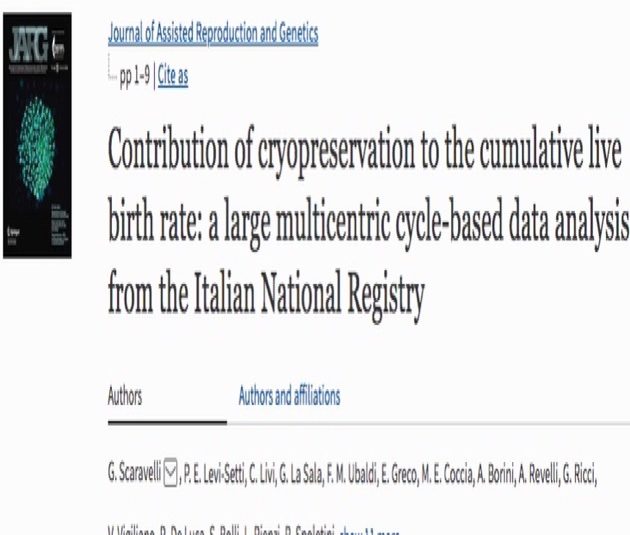
Contribution of cryopreservation to the cumulative live birth rate: a large multicentric cycle-based data analysis from the Italian National Registry
Scaravelli G, Levi-Setti P.E, Livi C., La Sala G., Ubaldi F.M, Greco E., Coccia M.E, Borini A., Revelli A., Ricci G., Vigiliano V., De Luca R., Bolli S., Rienzi L., Spoletini R., Drovanti A., Benini F., Villani M.T, Albricci L., Varricchio M.T, Basile V., Cattoli M., Nizzi A., Skerk K., Speziale L., Fiaccavento S..
Journal of Assisted Reproduction and Genetics, 2019 Aug 28. doi: 10.1007/s10815-019-01566-y
ABSTRACT
PURPOSE: To estimate the contribution of cryopreservation to the cumulative live birth rate (CLBR) after law modification in Italy in the era of vitrification and freeze-all.
METHODS: The Italian National Registry performed a cycle-based data collection. Nine Italian IVF clinics were involved incorporating a total of 10,260 fresh cycles performed between January 2015 and April 2016 resulting in 9273 oocyte retrievals and 3266 subsequent warming cycles from the same oocyte retrievals performed up to December 2016. Mean female age was 37 ± 4.3 years. Primary outcome measure was CLBR per oocyte retrieval. Confounding factors were tested in multivariate regression analysis, and the relative impact of cryopreservation to the CLBR in different patient categories was calculated.
RESULTS: CLBR per oocyte retrieval was 32.6%, 26.5%, 18.7%, 13.0%, and 5.5% for women younger than 36, aged 36-39, 40-41, and older than 41 years, respectively. The total relative contribution of oocyte/embryo cryopreservation was 40.6% (95% CI 38.41-42.75). An association between maternal age, number of oocytes retrieved, fertilization rate, cryopreservation, and cumulative live birth was shown. When adjusted for confounders, a 2.3-fold increase was observed in the chance of live birth when cryopreservation was performed (OR 2.3; 95% CI 1.99-2.56). In high responder patients (> 15 oocytes retrieved) where freeze-all was applied in 67.6% of cycles to avoid the risk of hyper stimulation syndrome, the relative contribution of vitrification to the CLBR was 80.6%.
CONCLUSIONS: Cryopreservation is essential in IVF and should always be available to patients to optimize success rates. Multicentric, cycle-based data analyses are crucial to provide infertile couples, clinicians, and regulatory bodies with accurate information on IVF effectiveness including fresh and cryopreserved cycles.
KEYWORDS: Cryopreservation; Cumulative delivery rate; ICSI; IVF; Live birth; National Register
